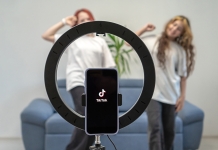Preparing to reopen: Patch testing and COVID-19 guidelines
As salons and beauty businesses prepare to return to work in the coming weeks, it's time to undertake some housekeeping to ensure that when you reopen, you're not only operating within government guidelines, but that you're also meeting the requirements of your AIT insurance policy.
One area it is imperative that you understand and follow the rules is patch testing for hair, eyelash, eyebrow tinting and perming treatments, which protects your clients as well as you and your business.
Why do we patch test?
Patch testing of hair, eyelash, eyebrow tinting and perming products is imperative to ensure that a client is not allergic or has a reaction to the products you are using. Reactions to chemical ingredients within hair colouring or perming solutions can be painful and dangerous to clients.
For your insurance to be valid, you must work in line with your manufacturer's guidelines and AIT's policy wording.
Always carry out a patch test:
- Before the provision of the first treatment
- After a change in a client's medical history. AIT has not received any update from the insurer that would suggest a vaccination would represent a change in a client's medical history (unless of course their GP has advised them of this).
- If you have changed any preparations used in hair, eyelash, eyebrow tinting and perming treatments or changed the manufacturer of your products
- At a 12 month interval since the last treatment
Should a client experience a reaction to products that you have applied to them during a treatment and can prove that you did not patch test them appropriately, you could be liable to legal action against you.

Your AIT policy warrants that a skin patch test is made at least 24 hours before applying any hair, eyelash, eyebrow tinting and perming products to the client for the first time.
If a returning client was treated by yourself/a member of your team for hair, eyelash, eyebrow tinting and perming treatments within the last 12 months, and you have not changed the products you are using and the manufacturers have not changed their formulations, you do not need to re-test them. If a client has not had a lash or brow tinting or perming treatment within the last 12 months, you must carry out a patch test.
If you change any of the products you use in your hair, eyelash, eyebrow tinting and perming treatments, you need to re-test clients 24 hours prior to their treatment.
How do you patch test and record the results?
You should carry out the patch test in line with product manufacturer's guidelines and in a way that you were taught during your training.
When you carry out your patch test, you should advise your client that they must contact you should any reaction to the product take place.
You should keep a record of patch tests carried out on your client's consultation card, whether that's a physical card or digital record, making sure you include the date that the test was carried out, which products you used, and whether your client reports any issues. Your client should also sign a consent form to acknowledge that they have undergone a patch test and understand what to do in case of an adverse reaction to products.
You must keep this record for at least seven years following the last occasion on which treatment was given. Without any record or proof that you carried out a patch test, insurers would have no way of defending you should an allegation be made against you.
It is not acceptable for a client to sign a waiver in place of a patch test.

If a client aged under the age of 16 years requests a treatment, you must have written consent from a parent or guardian, and a parent/guardian present during the patch test and treatment.
You must follow manufacturers' guidelines on treating those aged under 16 years of age, and work in line with the training you have undertaken, as some treatments, brands and products specify a minimum age.
Should I patch test pregnant or breast feeding clients?
When a client tells you that she is pregnant or breast feeding, you should add this to their client record card. You should follow patch protocol on any client that you are planning on carrying out hair, eyelash, eyebrow tinting and perming treatments on. This should be in line with your product manufacturer's guidelines and what you have been taught in training for each treatment; i.e. if a treatment is not recommended during the first trimester of pregnancy, then you should not carry out a patch test or subsequent treatment.
What if my client has a reaction to a patch test?
If, after carrying out a patch test, a client has a reaction to a product you are using, you must not carry out the full treatment. Insurance cover does not apply to any incident which may arise from treatment given following an allergic reaction to a patch test.
Should there be an allergic reaction to the patch test, insurance underwriters will not be liable for any claim which may arise from eyelash or eyebrow tinting treatment given following such a test.
If a client arrives for their full treatment after the patch test, and you can see there is an adverse reaction on the skin to the product you have applied, you should not go on to perform the treatment.
What if a client refuses a patch test?
You should not feel pressured by a client into carrying out a treatment without a patch test, or by undertaking a treatment after a reaction to a patch test.
Explain that patch testing is it a requirement of undergoing a hair, brow, lash tinting or perming treatment at your salon, and this is in line with standard industry practice. Do not treat a client that refuses a patch test.
As an industry professional, you have a responsibility to the wellbeing of your client, but you also have a responsibility to yourself and your business. It is better to lose a client by refusing to treat them, than leaving yourself liable to legal action and the financial consequences of this.
Legal advice states that if you agree with a client to circumvent any warranted procedure (i.e., a client refuses a patch test and you go on to perform a treatment that requires a patch test, even if the client signs a waiver), courts will usually award damages against you in any claim then made. In such circumstances, your AIT insurance policy would be invalid.
Have patch testing rules changed due to COVID-19 restrictions?
No, AIT's requirement for patch testing prior to hair, eyelash, eyebrow tinting and perming treatments has not changed. For your insurance to be valid, you must work in line with your manufacturer's guidelines and in line with AIT's policy wording, including carrying out a patch test 24 hours before a first treatment, after a change in the clients' medical history, when any hair, eyelash, eyebrow tinting and perming products or techniques have changed, and after a 12-month interval since the last treatment.
AIT has not received any update from the insurer that would suggest a vaccination would represent a change in a client's medical history (unless of course their GP has advised them of this).
What if I need to patch test prior to a treatment, but my business isn't yet open due to COVID-19 restrictions?
You must continue to operate your business in line with guidelines relevant to your area, and you cannot carry out a patch test whilst close contact or personal services are prohibited.
If your salon is unable to open yet, or you are not yet allowed to visit clients in their homes for treatments, then you cannot carry out a patch test. If this is the case, you should book clients for treatments on a date that allows you to patch test on your premises, or within clients' homes if you work mobile, 24 hours prior to treatment.
AIT does not recognise any at-home patch testing kits for clients to perform themselves, apart from those for HD Brow and Nouveau LVL Lash treatments.
What if the product manufacturer is offering a different way to patch test during COVID-19 restrictions?
You should always carry out a patch test in line with product manufacturer's guidelines. Therefore, if a manufacturer has created a new protocol for patch testing, and you follow this exactly and adhere to AIT's policy wording, your insurance would be valid.
Could the COVID-19 vaccine cause an adverse reaction to a product's ingredients?
AIT are unable to offer any medical advice. Therefore, if you, or a client, are concerned about COVID-19 vaccines in relation to beauty or hair treatments, you should contact your product manufacturer. If they are also unsure, you would be best getting a GP referral to ensure you are covered.
Do my clients have to have had a COVID-19 vaccine to attend the salon?
No. Once government guidelines allow close contact services to reopen, you may treatment clients as usual in line with COVID-19 regulations for close contact services. You, your staff or your clients do not need to have been vaccinated.
What to do if a client presents with an adverse reaction to a treatment you have carried out
Where any incident occurs that may lead to a claim being made you must notify AIT as soon as possible, as any undue delay could affect your claim. You will need to provide full information, your version of events and the client record card.
See guidance on what to do and for more information on your patch testing obligations in
AIT's Health Professional Scheme booklet.





